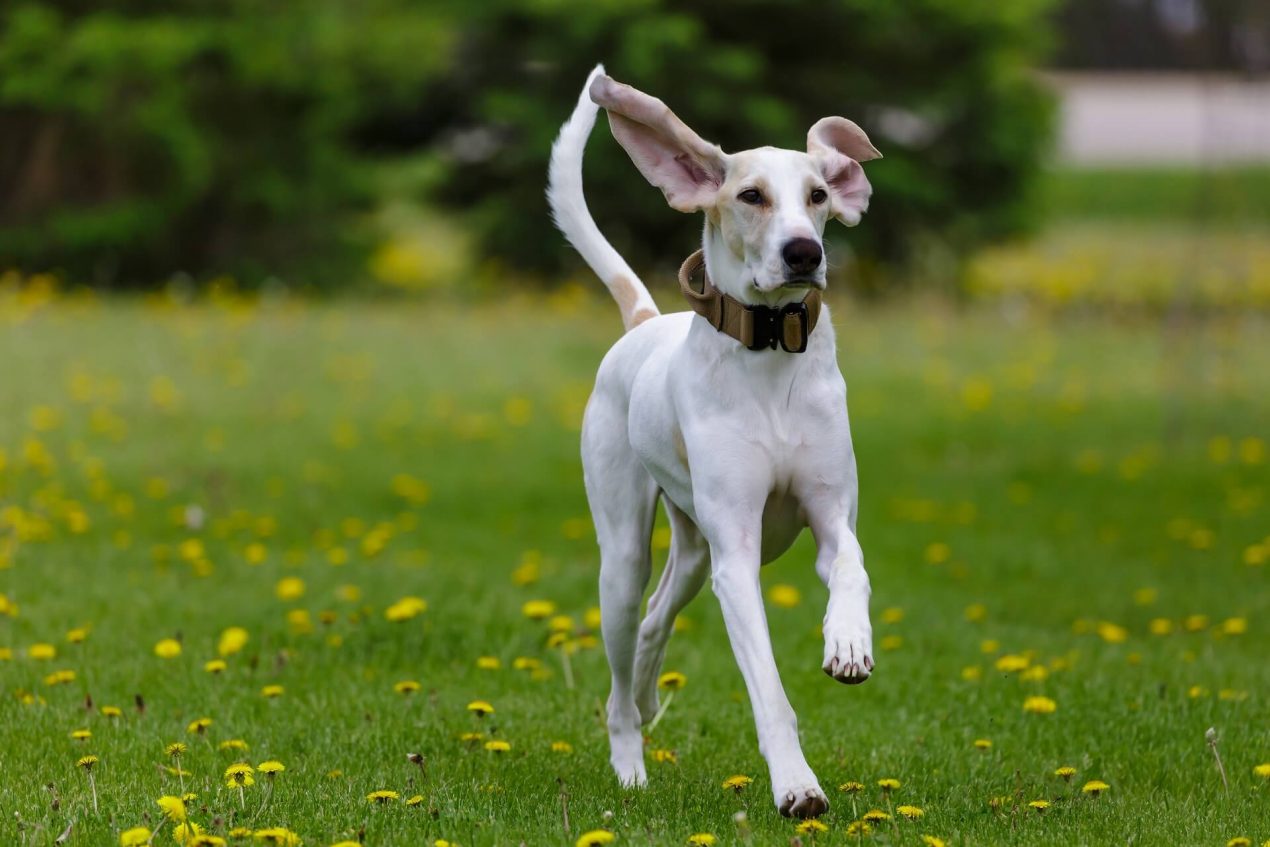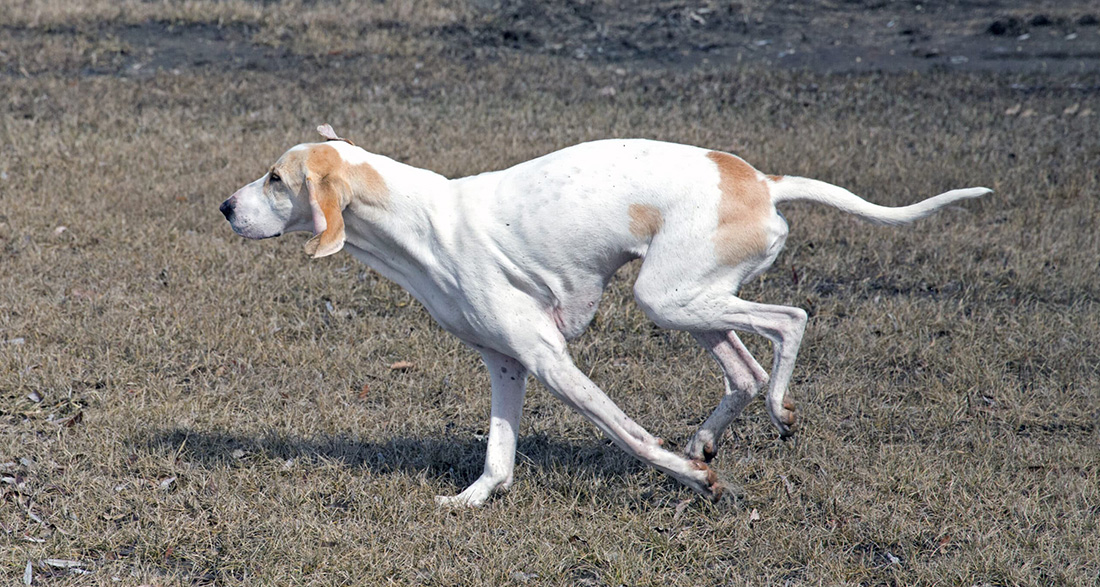The Porcelaine represents a snow-white canine beauty that is by no means fragile, as its name might suggest. “Porcelaine” comes from French and translates to “Porcelain.” The name rather refers to the porcelain color of its noble coat. Learn more about this French hunting dog in the following article.
History of the Porcelaine
The ancestors of the Porcelaine were hunting dogs from the Middle Ages, mainly owned by the nobility. The French King Louis IX is said to have also owned these beautiful, noble hunting dogs. Mainly in France, Italy, and Switzerland, the Porcelaine faithfully served its master as a pack hound primarily in small game hunting.
The Porcelaine, then known as the “Hund Briquet Francs,” was almost extinct by the time of the French Revolution in 1789. Its rescue is owed to breeders from Switzerland in 1845.
In the mid-19th century, the Somerset Harrier and the Grand Gascon Saintongeois were then crossed. The noble hunting dog is said to have received the name “Porcelaine” from the noble writer Marquis Théodore de Foudras, who had a weakness for hunting. After the breed was established, it was presented at dog shows from 1898 onwards. In 1964, the Chien de Franche-Comté, as the hunting dog is also called, was recognized by the FCI as a French breed. It bears FCI Standard No. 30 and belongs to FCI Group 6 “Scenthounds and related breeds,” Section 1 “Scenthounds,” 1.2 “Medium-sized Scenthounds.”
Breed Overview
GROUP: Hound
HEIGHT: 21.5 to 23.5 inches
WEIGHT: 55 to 62 pounds
COAT: Short, dense coat
COAT COLOR: pure white with distinct orange markings on the ears and body
LIFE SPAN: 12 to 13 years
TEMPERAMENT: Friendly, sociable, and intelligent
HYPOALLERGENIC: No
ORIGIN: France
Appearance of the Porcelaine
The Porcelaine has a slender, graceful body carried by high legs. Its porcelain-colored, silky-shiny, dense fur has orange, smaller or larger, round spots, often around the ears, on the body. Its drooping ears are also orange in color and reach down to its muzzle. The Porcelaine carries its thin, medium-length tail slightly curved and gazes out with gentle, dark eyes.
Character and Temperament
The Porcelaine’s temperament is characterized by friendliness and gentleness, provided the four-legged friend is adequately stimulated. The passion of the Porcelaine is hunting, and he carries this out very conscientiously when led for hunting. He has an excellent sense of smell, which is perfect for flushing out small game like hares or pheasants. The Porcelaine is very intelligent and can act independently.
He pursues his prey tirelessly, without showing signs of fatigue. He gives the so-called tracking cry, which always indicates to the hunter where he and the game are located. A hunter who knows his hunting companion well also knows how to interpret his various “barking styles.” Depending on the situation, the Porcelaine barks in a different tone. Heat doesn’t bother the dog during the hunt. He also hunts tirelessly in cold, wet weather; however, his fine coat provides less protection against the cold.
If the Porcelaine does not live in a hunting household, then the energetic endurance runner definitely needs mental and physical activities to be calm and balanced. Then he also feels comfortable in a “normal,” very active family. The gentle, snow-white beauty also gets along well with children who show him the proper respect. Therefore, the children in his pack should be a bit older and more understanding.
| Affection Level | Medium |
| Friendliness | Medium |
| Kid-Friendly | High |
| Pet-Friendly | High |
| Exercise Needs | High |
| Playfulness | High |
| Energy Level | High |
| Trainability | High |
| Intelligence | High |
| Tendency to Bark | Medium |
| Amount of Shedding | Low |

Since the Porcelaine used to live and hunt outdoors as a pack hound alongside other hunting dogs, it is very socially compatible. It can definitely live with other dogs or even cats if introduced properly from an early age. However, there might be issues with smaller pets, as the hunting dog may see them as prey.
The Porcelaine dog is not necessarily a natural guard dog. While it will alert to unfamiliar visitors, it does so gently and never aggressively. Initially, the furry friend may be somewhat reserved but friendly towards strangers.
Acquiring a Porcelaine
You should only get a Porcelaine puppy if you have enough time and willingness to provide it with appropriate mental and physical stimulation. As a hunting assistant, the white beauty is the ideal dog but not solely as a companion dog. It needs to be mentally and physically engaged to be happy.
What should I consider when buying?
Since the Porcelaine was originally bred exclusively for hunting, there are only a few breeders. Responsible Porcelaine breeders belong to a breeding association and often only place their offspring in the hands of hunters to ensure that the puppy is kept appropriately. A conscientious Porcelaine dog breeder will therefore thoroughly vet you if you are not a hunter. You should only buy Porcelaine puppies with pedigrees and ensure that there has been no inbreeding with the parent animals, as this increases susceptibility to diseases. A Porcelaine dog from a reputable breeder costs from $500 upwards with papers.
Development and Puppy Training
Although the Porcelaine is a spirited dog, it is easily and well trained with love, patience, and above all, consistency. It is very trainable and will gladly serve its master.
If the Porcelaine is not trained for hunting, it should be socialized well as a puppy. A visit to puppy and young dog school is advisable. Since the Porcelaine dog is naturally very socially compatible, it will enjoy playing and romping with other furry friends. Many dog schools also offer courses as a substitute for hunting, where the four-legged friend can perform a lot of scent work like on a hunt.
The intelligent puppies will also quickly learn that a well-groomed Porcelaine needs brushing as well as cleaning its ears and teeth. Veterinary visits, car rides, and everything else that is new to him should be included in the little one’s training plan. Teaching the recall from off-leash may be challenging, as with all passionate hunting dogs. It’s best to always practice with a long line and keep him leashed for safety.

How do I keep a Porcelaine?
The Porcelaine dog breed needs plenty of space, exercise, and mental stimulation. It is most comfortable in the countryside, in a large house with its own garden. The garden should be “secured” so that the hunting dog can move freely without escaping at the sight of “prey.” Otherwise, the furry friend enjoys an active family life.
Activities with the Porcelaine:
The four-legged bundle of energy must be allowed to exert itself to be content. Both hunters and very athletic owners with plenty of time can provide this for the Porcelaine dog. It is the ideal companion for long jogging sessions, bike or rollerblading tours, as well as extensive walks. The Porcelaine will also gladly accompany you on your vacation. Well-behaved, you can take him anywhere. Remember that he also needs sufficient exercise and mental stimulation during vacation.
Since the Porcelaine has a strong hunting instinct, it’s best to always keep him on a leash. A long lead gives the dog a lot of freedom while providing you with the assurance that he will actually come back to you when he senses wild game.
Furthermore, you should stimulate the furry friend’s brain by engaging in games with him. The hunting dog loves scent-tracking games in the woods and fields, as well as intelligence games. Likewise, the intelligent energy bundle enjoys many types of dog sports. For example, you can do tracking, canicross, or agility with him. With his excellent sense of smell coupled with intelligence and a calm temperament, he is also suitable for mantrailing.
After “work,” an energetic hunting dog also needs an extensive rest period. He will then be calm and content at home, enjoying cuddle sessions.
Health and Grooming
The Porcelaine dog breed is very robust and tough. Since he is very eager to work and enjoys running, he is also not prone to overweight – provided he is kept in an appropriate environment and fed a healthy diet. His life expectancy is between 10 and 13 years. Diseases may occur due to breeding, for example, if inbreeding has been practiced.
Grooming the hunting dog’s coat is straightforward. The smooth coat is easy to brush and can be wiped clean with a damp cloth if dirty. During shedding season, it’s best to brush him every day to prevent dead hair from spreading around the house. Likewise, you should always check the four-legged friend for ticks and parasites after a walk. Because the furry friend likes to rummage in the undergrowth and thickets.
You should also check the Porcelaine’s drooping ears regularly and clean them if necessary. Floppy ears are less ventilated and prone to ear infections when dirt and bacteria accumulate. A well-groomed Porcelaine also has his teeth brushed regularly with dog toothpaste and receives a daily chew bone for dental care. It’s best to give him dried beef scalp after his “workday.”
If your Porcelaine is already in his senior years, you may need to trim his nails. Because too long nails can easily get caught somewhere and tear off.
Porcelaine’s Nutrition:
An energetic Porcelaine that is adequately stimulated should receive a balanced diet with plenty of meat, vitamins, and minerals – whether as dry, wet food, or through barfing. The best choice is a high-quality food for active dogs – without flavor enhancers, chemical additives, sugar, and preferably without grain. Make sure that the dog takes a sufficiently long rest period after eating to prevent dangerous gastric torsion. The hunting dog should receive two meals a day, tailored to his age and activity level.
Interesting and Worth Knowing
The skin of the Porcelaine is thin, just as one would expect from fine porcelain. Under his coat, he has several black pigment spots.
Do you have a Porcelaine or are you considering getting one? Tell us in the comments what makes him special in your opinion!


